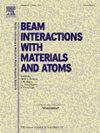Effects of Ge ion irradiation on dielectric properties of Si-based PiN diodes
IF 1.4
3区 物理与天体物理
Q3 INSTRUMENTS & INSTRUMENTATION
Nuclear Instruments & Methods in Physics Research Section B-beam Interactions With Materials and Atoms
Pub Date : 2025-04-09
DOI:10.1016/j.nimb.2025.165692
引用次数: 0
Abstract
The effects of 212 MeV Ge ion irradiation with various irradiation fluences on the dielectric properties of Si-based PiN diodes have been investigated. SRIM simulations demonstrate that Ge ion irradiation primarily induces silicon vacancy (VSi) defects, leading to the alteration of the silicon lattice structure. The electrical characterization analysis indicates that the impact of Ge ion irradiation on the electrical characteristics of the device is negligible. However, there is a positive correlation between the variation in the dielectric constant (ε’) and the irradiation fluence, wherein ε’ peak shifts towards higher frequencies and the dielectric loss (ε’’) decreases. Raman spectroscopy reveals a significant decrease in the intensity of the main peak at 525 cm−1, accompanied by an increase in the full width at half maximum (FWHM). These observations suggest that Si-Si bonds within the silicon lattice structure might have been broken due to Ge ion irradiation. The deep level transient spectroscopy (DLTS) results also demonstrate a positive correlation between the V2(0/−) bulk defects and irradiation fluence. These findings provide important insights into the design of radiation hardened devices, particularly relevant to aerospace and nuclear applications. Furthermore, the correlation between bulk defects and dielectric behaviour provides new avenues for optimizing high-frequency communication systems and energy-efficient semiconductor devices, thus enhancing the relevance of silicon technology in next-generation electronics.
锗离子辐照对硅基PiN二极管介电性能的影响
研究了212 MeV锗离子辐照对硅基PiN二极管介电性能的影响。SRIM模拟表明,锗离子辐照主要引起硅空位(VSi)缺陷,导致硅晶格结构的改变。电学特性分析表明,Ge离子辐照对器件电学特性的影响可以忽略不计。而介电常数ε′的变化与辐照通量呈正相关,ε′峰向高频偏移,介电损耗ε′′减小。拉曼光谱显示,525 cm−1处的主峰强度显著降低,半峰全宽(FWHM)增加。这些观察结果表明,硅晶格结构中的Si-Si键可能由于锗离子辐照而被破坏。深能级瞬态光谱(DLTS)结果也表明V2(0/−)体缺陷与辐照通量呈正相关。这些发现为辐射硬化设备的设计提供了重要的见解,特别是与航空航天和核应用相关。此外,体缺陷和介电行为之间的相关性为优化高频通信系统和节能半导体器件提供了新的途径,从而增强了硅技术在下一代电子产品中的相关性。
本文章由计算机程序翻译,如有差异,请以英文原文为准。
求助全文
约1分钟内获得全文
求助全文
来源期刊
CiteScore
2.80
自引率
7.70%
发文量
231
审稿时长
1.9 months
期刊介绍:
Section B of Nuclear Instruments and Methods in Physics Research covers all aspects of the interaction of energetic beams with atoms, molecules and aggregate forms of matter. This includes ion beam analysis and ion beam modification of materials as well as basic data of importance for these studies. Topics of general interest include: atomic collisions in solids, particle channelling, all aspects of collision cascades, the modification of materials by energetic beams, ion implantation, irradiation - induced changes in materials, the physics and chemistry of beam interactions and the analysis of materials by all forms of energetic radiation. Modification by ion, laser and electron beams for the study of electronic materials, metals, ceramics, insulators, polymers and other important and new materials systems are included. Related studies, such as the application of ion beam analysis to biological, archaeological and geological samples as well as applications to solve problems in planetary science are also welcome. Energetic beams of interest include atomic and molecular ions, neutrons, positrons and muons, plasmas directed at surfaces, electron and photon beams, including laser treated surfaces and studies of solids by photon radiation from rotating anodes, synchrotrons, etc. In addition, the interaction between various forms of radiation and radiation-induced deposition processes are relevant.

 求助内容:
求助内容: 应助结果提醒方式:
应助结果提醒方式:


